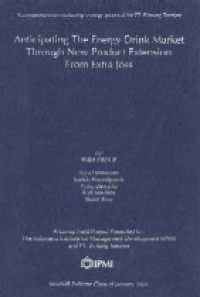
PT Ericsson Indonesia mobile phone business plan for year 1999-2000
| Gmd : Text
| Availability :
| 00000008508 | 177 | (GFP) | Available - Ada |
CHAPTER I
INTRODUCTION
1.1 GENERAL
Ericsson is a global Swedish company with a very strong development in mobile phones and the leading supplier in digital mobile phones. 1997 worldwide net sales were $20,968 millions and total expenses for R&D accounted to $2,613 millions, or 12 % of net sales.
Ericsson entered the Indonesian market in 1995 with GSM 900 system and became the market leader in the industry with a market share of 43 % in 1997. The market growth has been on average of 60 % per year since 1986 and Ericsson was expecting to keep its position as market leader.
Unfortunately, the Indonesian economic turmoil has made all the expectation gone away. During the first six months of 1998, rupiah has been experiencing huge depreciation against US dollar, interest rate has been going very high, inflation rate has achieved about 50 % and GDP was falling down. This macroeconomic condition has caused the mobile phone market in Indonesia shrink significantly. Ericsson, as the market leader, has suffered most since it was losing its market. This unfavorable condition was worsened by the Jakarta riot, which happened in mid May, which destroyed the distribution network of Ericsson. But, despite the unfavorable macroeconomic condition, Nokia, Ericsson's main competitor, was entering the market very aggressively. Nokia is launching new products: Nokia 6110 and Nokia 5110. With its aggressive sales and marketing actions, Nokia has taken over the market leadership position from Ericsson.
Facing this situation, Ericsson should re-formulate its business strategy to regain its leading position in the industry.
1.2 PROBLEM STATEMENT
1.2.1. Ericsson was losing its position as market leader in mobile phone industry in Indonesia due to the following conditions:
.Unfavorable macroeconomic conditions which cause market shrinkage.
.Aggressive attack by its maip competitor, Nokia
1.2.2. In view of the heavy financial burden on Ericsson, should Ericsson let go its market for the time being and then come back when the macroeconomic condition has become favorable? Or should Ericsson bear the financial burden (loss) to maintain its share of market?
1.3 OBJECTIVES
1.3.1. To analyze Ericsson business environment in Indonesia (and its relation with Ericsson as the global player in mobile phone industry) with concerns in the following areas:
.Threats of new entrants .Threats of substitutes
.Bargaining power of suppliers .Bargaining power of buyers
.Rivalry among existing competitors within the industry.
1.3.2. To explore Ericsson's competitive advantages in Indonesia and (as a global company) on a worldwide basis.
1.3.3. To formulate the marketing strategy (segmentation, targeting, positioning) and the marketing mix (product, price, place and promotion) for Ericsson for year 1999 -2000.
These objectives will become useful inputs for PT Ericsson Indonesia in formulating its business strategy for the year 1999 -2000 whether Ericsson should regain its position as market leader or it should focus only on profitability for the time being.
1.4 SCOPE OF GFP
The scope of this GFP is limited to four largest mobile phone players in indonesia: Ericsson, Nokia, Motorola and Siemens, which constituted 89 Jercent of total market share.
Explanation on mobile phone industry in Indonesia and in the world, as well as on Ericsson is provided in chapter 2 that will function as background information for further analysis.
Macro-environment analysis is done in chapter III that includes Technology, Political, Economy, Legal, and Socio-cultural analysis. While mobile phone industry analysis is done in chapter IV, using Michael Porter's model of "Five Forces of Competition", which consists of:
The rivalry among competitors
STP and 4Ps analysis of the Indonesian mobile phone major players in the market: Ericsson, Nokia, Motorola and Siemens.
Suppliers
Analysis of the relationship between PT. Ericsson Indonesia and its Parent Company as the hardware supplier. Analysis of the competitors and their relationship with their Principal Company.
The Buyers
Buyers of the mobile phones are the Distributors. They sell the phones further to the end-users via Dealers and Retailers. Foreign ors in Indonesia, as Ericsson, are not permitted to do any retail g in Indonesia. Analysis of the buyers also includes end user, especially in the light of current economic crisis.
Substitutes
Analysis of substitute products available in the market that will affect lies of mobile phones. Analysis of new technology that may affect the sales of mobile phones in Indonesia.
New entrants
Analysis of possible new competitors and how they will affect the market.
Analysis on PT. Ericsson Indonesia in particular is done in Chapter V, which include essessments on its Strengths and Weaknesses as well as its STP (Segmentation, Targeting, Positioning) and 4Ps (Product, Price, Place, Promotion) compared to its closest competitor, Nokia.
Finally, recommendation is given to PT. Ericsson Indonesia, which includes STP and 4Ps for Ericsson's business plan in year 1999-2000.
| Series Title |
-
|
|---|---|
| Call Number |
177
|
| Publisher Place | Jakarta |
| Collation |
65p.: figs., tabs.; 27cm
|
| Language |
English
|
| ISBN/ISSN |
-
|
| Classification |
NONE
|
| Media Type |
-
|
|---|---|
| Carrier Type |
-
|
| Edition |
-
|
| Subject(s) | |
| Specific Info |
-
|
| Statement |
-
|
| Content Type |
-
|
No other version available







